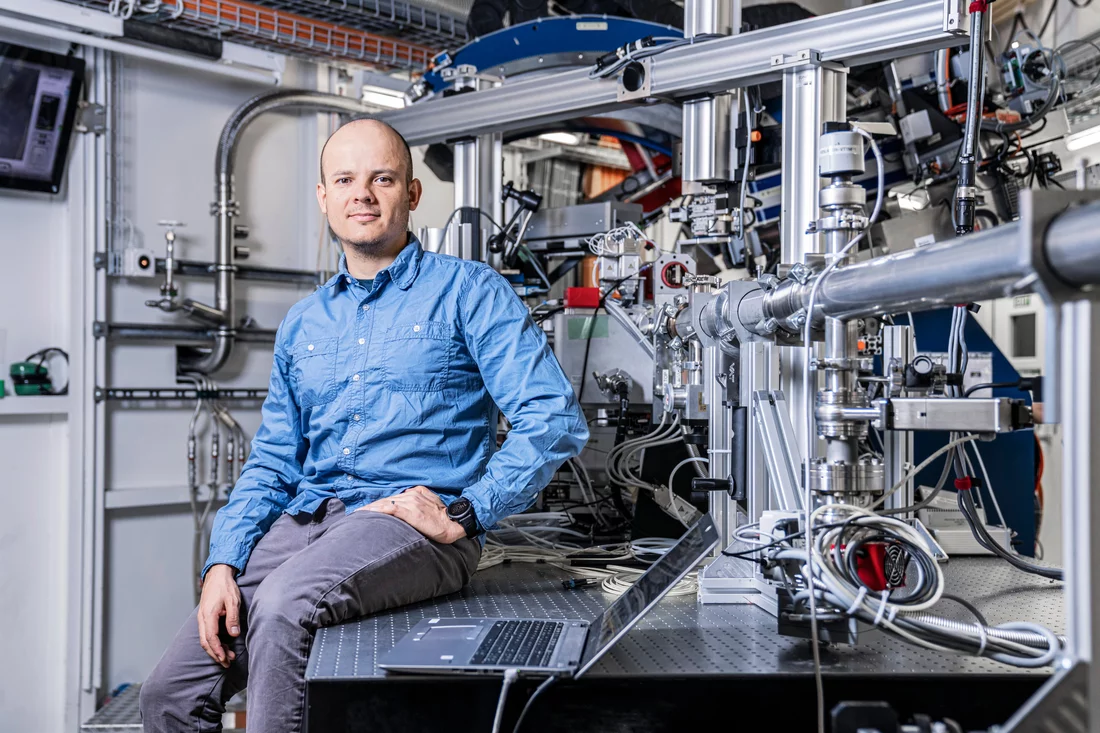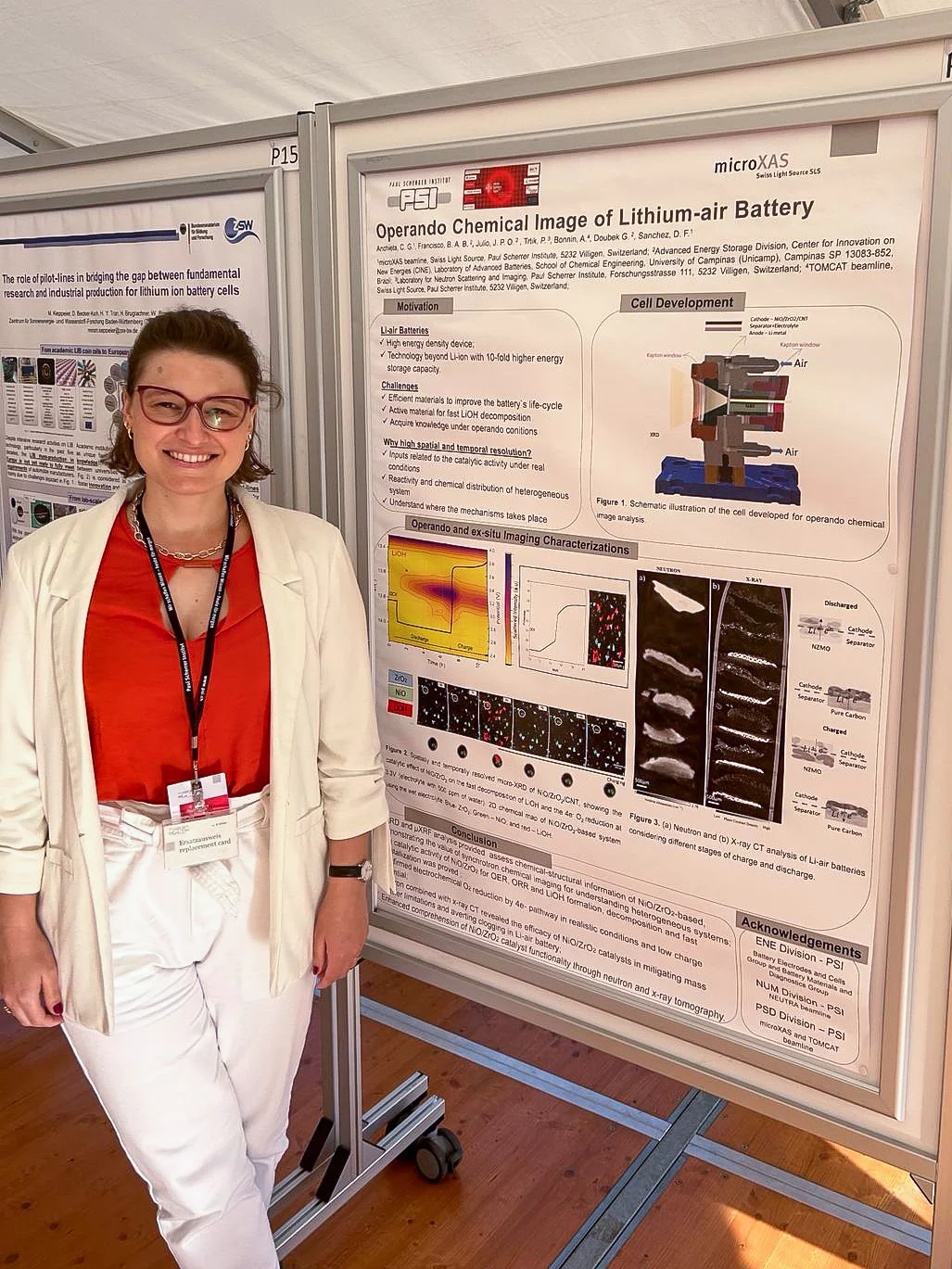Thanks to the unique combination of diverse large research facilities at the Paul Scherrer Institute PSI, researchers were able to uncover a possibility for optimising so-called lithium-air batteries. They showed that adding a catalyst reduced chemical decomposition processes in the batteries, thus significantly extending their service life.
Lithium-ion batteries are considered an important component of a climate-neutral future. So-called lithium-air batteries, on the other hand, are not well known – mainly because they have a very limited service life. These types of batteries are unbeatable, however, in one point: their energy density. It should theoretically be possible to store ten times as much energy in them as in conventional lithium-ion batteries of the same weight – almost as much per kilogram as in fossil fuels. For electromobility, that would be a dream come true. After just a few charging cycles, however, such batteries show massive losses of storage capacity.
To overcome this problem, researchers at PSI tested an innovative approach. They added a mixture of nickel oxide and zirconium dioxide to the battery. The two materials function as a catalyst in the battery, preventing the buildup of chemical products that arise during use and damage the battery. Using neutron beams and synchrotron light, the researchers were able to make the chemical processes in the battery during charging and discharging visible. In this way they showed how the catalyst functions. They have published their results in the current issue of the scientific journal Small Methods.
Current flow thanks to air supply
Light as air, that’s how they should be. Unlike conventional lithium-ion batteries, lithium-air batteries have no need for heavy graphite as the electrode material; rather, as the name suggests, they need only air – more precisely, the oxygen it contains. A lightweight, porous nanostructure ensures that oxygen from incoming ambient air is made available for a chemical reaction – specifically, what scientists refer to as reduction.
Now if lithium ions migrate from the negative pole of the battery to the positive, they react there with the oxygen to form lithium oxide – and current flows. During charging, the process is reversed: The lithium separates from the oxygen and flows back to the negative pole.
Reinterpreting a well-known catalyst
Doing without graphite and other metals makes lithium-air batteries, despite their high capacity, especially light and compact. However, this also exposes their weakness, because the nanostructure used, which is required for the oxygen reduction, is very vulnerable to by-products.
Besides oxygen, other components of the ambient air react with the lithium. Thus, for example, the formation of lithium hydroxide can significantly compromise the overall capacity of the battery and shorten its service life. “These by-products stop up the tiny holes in the nanostructure,” explains PSI scientist Dario Ferreira Sanchez. “As a result, no air can circulate and the battery stops working.”
To solve this problem, the researchers added a special catalyst to the battery cell. “It is known from the literature that nickel oxide and zirconium dioxide promote the enrichment of oxygen – exactly what we want in lithium-air batteries,” explains Chayene Gonçalves Anchieta, first author of the study. “To our amazement, though, we didn’t find one single study on this topic. So we tried it.” And with success. The team was able to show that adding the catalyst facilitates the decomposition of lithium hydroxide during the discharging process.
Unique insight thanks to complementary methods
The next step was to take a closer look at the chemical reactions. “It is particularly challenging to examine batteries because they are made up of many elements in a wide variety of arrangements,” explains Dario Ferreira Sanchez. “While heavy elements with crystalline structures can be imaged especially well with X-ray diffraction, light, amorphous lithium remains practically invisible.” To get a comprehensive picture, the researchers needed to combine different methods. “It’s absolutely unique here at PSI,» says Dario Ferreira Sanchez. «In this laboratory you measure one aspect, a hundred metres away you measure the other, and in the end you combine everything into the big picture.”
In X-ray diffraction at the Swiss Light Source SLS, they found a suitable tool for charting the chemical processes in the battery while it’s operating. Each type of atom can form in its own regular spatial arrangement, that is, in a crystal structure. When X-ray light strikes it, it interacts differently depending on the arrangement of the atoms – revealing a fingerprint that identifies which element is present. Through temporal mapping during battery operation, each respective element can precisely be located and tracked, for example where it accumulates or disappears again.
To make non-crystalline or amorphous structures visible, the researchers combined their toolbox with X-ray tomography. This imaging procedure works similarly to the computer tomography used in hospitals and provides a three-dimensional view of the battery including all the components within it. Now all that was missing was the lithium.
“Neutrons are especially sensitive with respect to lithium,” Sanchez explains. “So we took our probe to the Swiss spallation neutron source SINQ.” The object was illuminated from various angles with a neutron beam, and a three-dimensional tomographic image was assembled. “Our diffraction images enabled us to guess where the lithium should be. But all we saw was an empty space,” Sanchez recalls. «It was only in combination with the neutron images that we noticed: Wow, there is a lot in this empty space.”
The use of nickel oxide-zirconium dioxide catalysts in lithium-air batteries represents a significant step towards realising the full potential of this technology. For industrial implementation, however, it is still a bit too early – a number of engineering hurdles still need to be overcome.
Text: Paul Scherrer Institute/Benjamin A. Senn
© PSI provides image and/or video material free of charge for media coverage of the content of the above text. Use of this material for other purposes is not permitted. This also includes the transfer of the image and video material into databases as well as sale by third parties.
Contact
Dr. Dario Ferreira Sanchez
Laboratory for Femtochemistry
Paul Scherrer Institute, Forschungsstrasse 111, 5232 Villigen PSI, Switzerland
+41 56 310 52 41
dario.ferreira@psi.ch [English, French]
Original publication
LiOH Decomposition by NiO/ZrO2 in Li-Air Battery: Chemical Imaging with Operando Synchrotron Diffraction and Correlative Neutron/X-Ray Computed-Tomography Analysis
Chayene Gonçalves Anchieta, Bruno A.B. Francisco, Julia P. O. Júlio, Pavel Trtik, Anne Bonnin, Gustavo Doubek, Dario Ferreira Sanchez
Small Methods, 06.01.2024
DOI: 10.1002/smtd.202301749
Further information
- Better batteries for electric cars – text from 26 October 2023
- Look inside a chemical reactor – text from 15 December 2020


